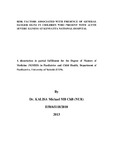| dc.contributor.author | Kalisa, Michael | |
| dc.date.accessioned | 2013-11-11T12:14:26Z | |
| dc.date.available | 2013-11-11T12:14:26Z | |
| dc.date.issued | 2013 | |
| dc.identifier.citation | Kalisa,Michael;2013.Risk Factors Associated With Presence Of General Danger Signs In Children Who Present With Acute Severe Illness At Kenyatta National Hospital. | en |
| dc.identifier.uri | http://erepository.uonbi.ac.ke:8080/xmlui/handle/11295/58495 | |
| dc.description.abstract | Back ground: Every year about 7 million children die before their 5th birth day. Most of these
deaths occur in developing countries. These deaths result from a disease or a combination of
diseases that can be prevented or treated by existing inexpensive interventions. The leading
causes of child deaths are; acute respiratory infections (18%), diarrhea (11%), malaria (7%),
measles (1%), and malnutrition increases the risk of dying from these diseases. Since most of
these deaths occur in developing countries compared to developed countries, understanding the
risk factors of the severe forms of illnesses may help in planning interventions for controlling
childhood morbidity and mortality.
Objective: To determine the risk factors associated with presence of general danger signs in
children who present with acute severe illness at Kenyatta National Hospital.
Methodology: This was a hospital-based, case-control study, carried out at the Kenyatta
National Hospital Paediatrics Emergency Unit. Children aged 2-59 months presenting at
Kenyatta National Hospital with signs and symptoms of acute severe illness were recruited, of
whom one hundred and forty two were cases and one hundred and forty two were controls.
Children were selected daily and enrolled after getting a written informed consent from their
caregivers. Data were checked for completeness, entered into Microsoft excel data sheet, cleaned
and exported to SPSS statistical package for analysis. Frequencies, means and proportions were
calculated. To compare means student t-test was used. Statistical significance was taken at the
level p < 0.05 and odds were calculated using both univariate and multivariate analysis.
Results: A total of 142 cases with general danger signs and 142 controls were included in the
study. Cases were slightly older than controls, their mean age in months being 14.16 (SD±11.83)
versus 12.68 (SD±10.3) respectively. Using multivariate logistic regression analysis, risk factors
independently associated with presence of general danger signs were; use of biomass as the
source of cooking fuel OR=3.38 (95% CI=1.41-8.06), P=0.006, severe pneumonia OR 5.2(95%
CI=3.0-9.2), P=<0.001, having more than one diagnosis in a child OR=3.68 (95% CI=2.00-6.77),
P= <0.001, and presentation to hospital for treatment later than 3 days of symptoms onset
OR=1.32 (95% CI=1.14-1.53), P=<0.001.
Conclusion: This study shows that socioeconomic factors such as use of biomass as cooking fuel
source is associated with presence of general danger signs in children with acute severe illness.
Severe pneumonia and having more than one diagnosis in a child were the clinical factors
associated with presence of general danger signs. Presentation to hospital for treatment later than
3 days was also associated with presence of general danger signs.
Recommendation: Use of cleaner fuels such as natural gas and electricity is recommended over
biomass. Integrated approach to management of children who present with general danger signs
is of utmost importance to deal with the multiple illnesses and there is need to educate
parents/caregivers and communities about simple signs of diseases that suggest a need for
seeking professional medical attention. | en |
| dc.language.iso | en | en |
| dc.publisher | University of Nairobi | en |
| dc.title | Risk factors associated with presence of general danger signs in children who present with acute severe illness at Kenyatta National Hospital | en |
| dc.type | Thesis | en |
| dc.description.department | a
Department of Psychiatry, University of Nairobi, ; bDepartment of Mental Health, School of Medicine,
Moi University, Eldoret, Kenya | |
| local.publisher | Department of Paediastrics, University of Nairobi. | en |

